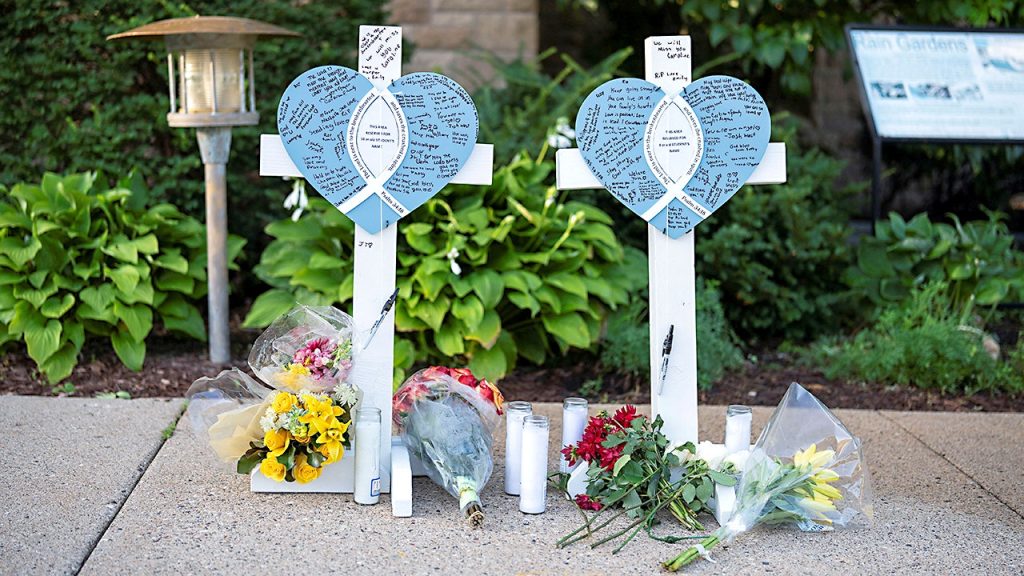Tragedy at Minneapolis Church: A Community in Mourning
In a devastating attack that shattered the peace of Annunciation Catholic Church in Minneapolis, an unimaginable tragedy unfolded during a Wednesday morning Mass, leaving two children dead and eighteen others injured. The most heart-wrenching account came from Jesse Merkel, father of 8-year-old Fletcher, one of the young victims. “Yesterday, a coward decided to take our 8-year-old son, Fletcher, away from us,” Merkel said, his words heavy with grief. “Because of their actions, we will never be allowed to hold him, talk to him, play with him and watch him grow into the wonderful young man he was on the path to becoming.” Fletcher was described as a boy who “loved his family, friends, fishing, cooking, and any sport that he was allowed to play.” Though the second victim, a 10-year-old student at the church’s school, has not yet been named, the community mourns deeply for both families thrust into this nightmare.
The shooting wounded eighteen others, with several remaining hospitalized in critical condition. Thirteen-year-old Endre Gunter was shot in the stomach and successfully underwent surgery. His mother, Danielle Gunter, expressed both grief and gratitude: “Our hearts are shattered — not only for him, but for everyone who was harmed. We grieve and we pray: for the others who were shot, for their families, and for those who lost loved ones.” She also shared a touching moment of humanity amid the horror, noting that a Minneapolis police officer had “rendered aid, hugged him, reassured him, and prayed with him” before the ambulance arrived. Another victim, 12-year-old Sophia Forchas, remains in critical condition after a difficult surgery. A Facebook post from St. Mary’s Greek Orthodox Church reported that “more will be determined by the loving and caring medical staff in approximately 2 to 3 days.” While Sophia fights for recovery, her younger brother, who was inside the school during the shooting but not physically injured, and her mother, a pediatric critical care nurse who learned of her daughter’s injuries while at work, wait by her side.
The attack occurred around 8:30 a.m. when the shooter fired dozens of rounds into the church, shattering stained-glass and pew-side windows as terrified students and parishioners sought shelter. Acting U.S. Attorney for Minnesota, Joe Thompson, revealed disturbing details about the shooter’s motives during a Thursday news conference. After reviewing hundreds of pages of writings left behind, Thompson stated bluntly that the shooter “wanted nothing more than to kill children” and “was obsessed with the idea of killing children.” Thompson refused to repeat the “horrific and vile” words but summarized that “the shooter wanted to watch children suffer.” The shooter, armed with three firearms, died from a self-inflicted gunshot wound at the back of the church after carrying out the attack. Authorities continue to investigate what drove this individual to target a place of worship filled with innocent children.
Minneapolis Mayor Jacob Frey captured the profound violation of sanctuary that this attack represented: “These kids were literally praying. It was the first week of school. They were in a church. These are kids that should be learning with their friends. They should be playing in the playground. They should be able to go to school or church in peace without fear.” The targeting of children in a space traditionally considered safe—both a school and a place of worship—has sent shockwaves through the community and the nation. The fact that this violence erupted during morning prayers, in a setting where families should feel most protected, has heightened the sense of vulnerability and outrage. Community members have begun creating memorials outside the church, leaving flowers, stuffed animals, and handwritten notes expressing their grief and solidarity with the victims’ families.
The tragedy has prompted national and international responses. President Donald Trump ordered all U.S. flags to be flown at half-staff until August 31, 2025, “as a mark of respect for the victims of the senseless acts of violence.” The White House confirmed that flags would be lowered across public buildings, military posts, and embassies worldwide—a solemn acknowledgment of the nation’s shared mourning. Pope Leo XIV sent condolences to Archbishop Bernard Hebda of Minneapolis, offering “his Apostolic Blessing as a pledge of peace, fortitude and consolation in the Lord Jesus” to the Annunciation Catholic School Community, the Archdiocese of Saint Paul and Minneapolis, and the people of the greater twin cities area. Religious leaders across denominations have called for prayer vigils and healing services in the wake of this violence against a faith community.
This shooting comes amid growing concerns over community safety, particularly in schools and places of worship. Recent weeks have seen a surge of active-shooter hoaxes and threats targeting U.S. college campuses, creating an atmosphere of heightened anxiety. For the Minneapolis community, the road to healing will be long and difficult. Support services have been mobilized for the families of victims, witnesses to the violence, and first responders who faced the traumatic scene. Mental health professionals emphasize that children and adults alike will need ongoing care to process what they’ve experienced. As Jesse Merkel reflected on the loss of his son Fletcher, he expressed a universal hope in the face of unspeakable loss: “While the hole in our hearts and lives will never be filled, I hope that in time our family can find healing. I pray that the other victim’s family can find some semblance of the same.” In these words lies the painful journey ahead—not just for the Merkel family, but for an entire community struggling to make sense of a senseless act of violence against its most innocent members.


